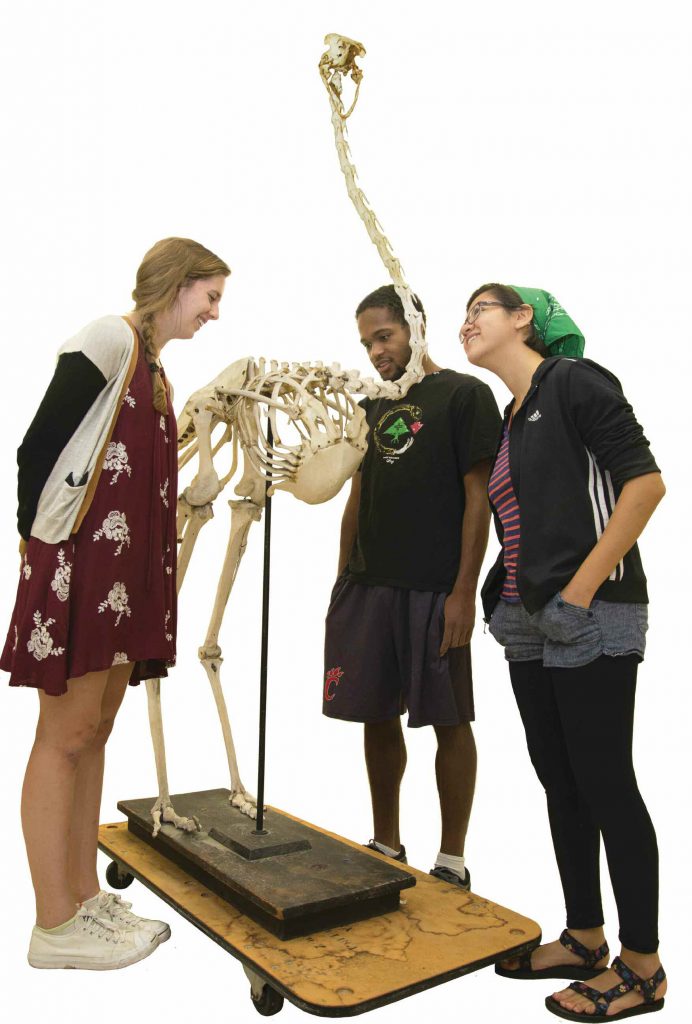 Jeffrey Allen ’17 (center), a teaching assistant in Professor of Biology Nina Karnovsky’s Avian Ecology class, joins Ellie Harris ’18 (left) and Vanessa Machuca ’18, students in the class, to examine the skeleton of an ostrich, part of the vertebrate specimens collection housed in the Biology Department. “From one look at the breastbone you can tell that this bird can’t fly,” Karnovsky notes. “There is no keel for flight muscles—it is totally smooth—plus the wings are tiny. It dramatically shows adaptations for running—lots of area for attaching leg muscles. I use this in my Vertebrate Biology class as well. I have no idea where it came from or how long we have had it. I just love it.”
Jeffrey Allen ’17 (center), a teaching assistant in Professor of Biology Nina Karnovsky’s Avian Ecology class, joins Ellie Harris ’18 (left) and Vanessa Machuca ’18, students in the class, to examine the skeleton of an ostrich, part of the vertebrate specimens collection housed in the Biology Department. “From one look at the breastbone you can tell that this bird can’t fly,” Karnovsky notes. “There is no keel for flight muscles—it is totally smooth—plus the wings are tiny. It dramatically shows adaptations for running—lots of area for attaching leg muscles. I use this in my Vertebrate Biology class as well. I have no idea where it came from or how long we have had it. I just love it.”
Articles Written By: emae2021@pomona.edu
Flightless to the Bone
A Chirping Start
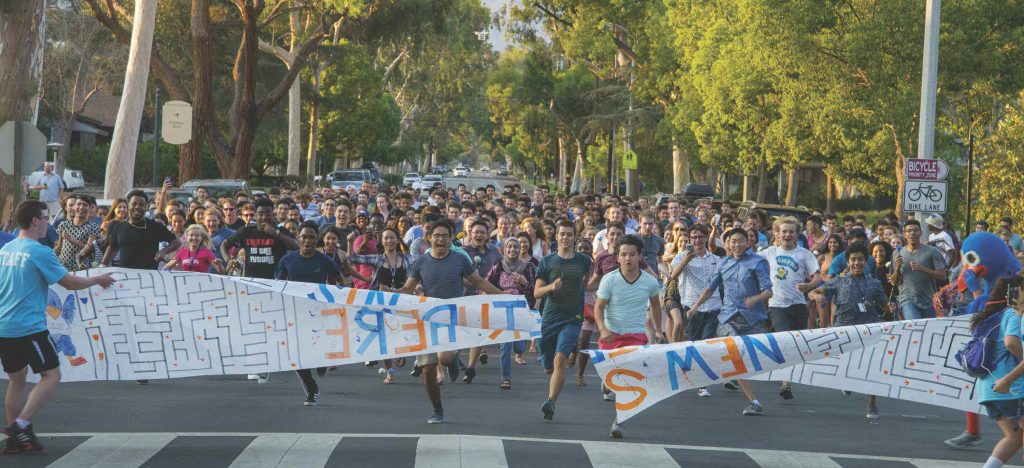
In late August, the Class of 2020 continued the Pomona tradition of “chirping through the gates” to begin their first semester at the College.
Bookmarks Fall 2016
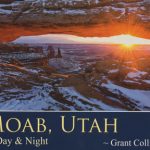 Moab, Utah by Day & Night
Moab, Utah by Day & Night
In his new book of landscape photography, Grant Collier ’96 shares the eerie beauty of earth and sky in the canyon country of eastern Utah. EXCERPT: “In my dreams, I occasionally find myself standing atop impossibly large arches or bizarre, almost whimsical pillars of stone. I will wander far too close to the edge, but I have little fear, as I am rapt in awe by the splendor of the scene. Only in the landscape around Moab do these dreams ever meld with reality. The scenery here is so otherworldly that it seems precariously balanced on the cusp of fantasy.”
 Walking with Alzheimer’s:
Walking with Alzheimer’s:
A Thirty Year Journey
This book by physician Shelly Kruse ’76 is both a personal memoir of her mother’s progressing illness and a guidebook for families and caregivers. EXCERPT: “My mother drove everyone crazy. Her favorite activity was calling out, ‘Help me, help me, help me.’ She sounded sincere and in trouble and would continue however long it took for someone to arrive. After the nurse or myself came running to ask, ‘What’s wrong, Jo?’ she would smile sweetly and reply, ‘Nothing.’ Then a few minutes later, she would do the same thing again.”
 The Fog Seller
The Fog Seller
This Sausalito-based, literary mystery from Don Daglow ’74, the creator of the Emmy Award–winning Neverwinter Nights, has won a number of awards. EXCERPT: “Liam the Fog Seller stands atop the round concrete bench in the Powell St. BART station, 50 feet below the streets of San Francisco. He wears a black satin top hat, a tuxedo with tails, baggy black pants, neon yellow T-shirt and a diaphanous pale blue scarf. “Ladies and Gentlemen!” he proclaims, drawing a glare from an old Chinese woman sitting nearby. “The trains that roll through this station will take you away from this place and time!”
 Rosa’s Very Big Job
Rosa’s Very Big Job
With illustrations by Sarah Vonthron-Laver, this children’s book by Ellen Mayer ’74, about a spunky preschooler named Rosa who enlists her imaginative grandfather to lend a helping hand to her busy mom, is part of Mayer’s new series of “Small Talk Books,” which are designed to demonstrate practical techniques parents can use to facilitate language development in their children. Other titles in the series include Cake Day, with illustrations by Estelle Corke, and a pair of board-books titled Red Socks and A Fish to Feed, both illustrated by Ying-Hwa Hu.
 The Legacy of the Moral Tale:
The Legacy of the Moral Tale:
Children’s Literature and the English Novel, 1744–1859
Patrick Fleming ’05 traces the rise of the moral tale in children’s literature and its impact upon such authors as Charles Dickens and Maria Edgeworth. EXCERPT: “By the time he wrote Great Expectations, Dickens had changed his didactic narrative style. Unlike his earlier novels, Great Expectations does not take the form of an example illustrating a moral precept, rewarding the virtuous characters and punishing the villains. If Great Expectations is to succeed in its didactic goals, the experience of reading the novel must accomplish this task.”
 Alphabet Fun:
Alphabet Fun:
Playing ‘Eye’
In her new children’s book, based on a game she plays with her grandchildren, Alice Ronald ’63 teaches imaginative observation using photographs of found alphabet letters in everyday objects. “When I was little,” she explains, “my father played a game with my brother and me. It was called Playing Eye. We looked for animal shapes in the clouds or slightly different colors and shapes in trees or flowers or rocks. Playing Eye trains young minds to observe and to use the artistic parts of their brains. I am continuing the Playing Eye game with my grandchildren.”
 Preparing to Teach Social Studies for Social Justice:
Preparing to Teach Social Studies for Social Justice:
Becoming a Renegade
Nick Henning ’95 and co-authors Ruchi Agarwal-Rangnath and Alison Dover offer a guide to teaching justice-oriented social studies classes within the Common Core State Standards. EXCERPT: “Before the beginning of each school year, every teacher is faced with the important content-focused curricular question, “What will I teach?” Embedded within this question are the corollary questions, “What do I want to teach?” and “What am I supposed to teach?” For most justice-oriented teachers in accountability driven classrooms, the answers to these two questions often do not match…”
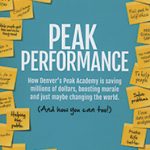 Peak Performance:
Peak Performance:
How Denver’s Peak Academy Is Saving Millions of Dollars, Boosting Morale and Just Maybe Changing the World. (And How You Can Too!)
J.B. Wogan ’06 joins co-author Brian Elms, a founding member of Denver’s Peak Academy, to offer a guide to improving organizational performance. EXCERPT: “It’s the small innovations that can transform a process—and the small questions that can cause you to reexamine the way something’s always been done. When you’re looking for an opportunity to innovate, think small, and ask yourself this question: Is there anything you do just because it’s always been done that way?”
The Elements of a President (Redux)

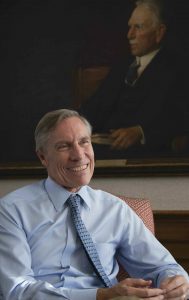
Thirteen years ago, as David Oxtoby was preparing to become the ninth president of Pomona College, this magazine introduced him to the College family with an article titled “The Elements of a President.” The title arose from a reference to one of his favorite books, The Periodic Table.
In my mind, he was a guy who thrived on opening new doors, and who didn’t shy away from difficult situations.
—Stewart Smith ’68
Former Chair of the Board of Trustees
He really believed in my potential, and he reminded me of that constantly.
—Shirley Ceja-Tinoco ’10
In this autobiographical work, Italian chemist and Auschwitz survivor Primo Levi famously titled each chapter with an element that he had worked with as a chemist or that was related in some symbolic way to his life.
Asked which elements he would choose to describe his own life, Oxtoby—as a fellow chemist with a similarly figurative turn of mind—played along.
He started with hydrogen, the first and simplest element, symbolizing his formative years. Next came gallium, an element with some odd properties that interested him in his research on nucleation, as well as being named in honor of France, the country where he met his wife, Claire. Chlorine, bromine and iodine, all part of the halogen family, represented his three children. All, he said, were part of a single family and yet each was utterly distinctive in character. To symbolize his years of teaching and research in atmospheric chemistry, he chose carbon, the key element for life. Finally, for his arrival at Pomona, he selected element number 47 on the periodic table, silver.
So naturally, as Oxtoby’s tenure as Pomona president entered its final months, we went back to him to ask how he would revise or add to that list today to characterize his presidency. Once again, he played along, and the result is a metaphorical reflection on some of the key themes of his transformative tenure at Pomona.
 Silver / The Liberal Arts
Silver / The Liberal Arts
“This time, I would start with silver, element number 47, therefore the Pomona element. A noble metal, it is important both aesthetically in the arts and as a catalyst for new chemistry, and so, it could be a symbol not only of Pomona, but more broadly of the liberal arts.”
David is not only a renowned scientist, but a powerful advocate for the arts.
—Louise Bryson
Trustee
I remember him telling us that our job was to do what was right, not what was popular.
—Lori Kido Lopez ’06
Some aspects of a presidency are easily quantifiable—gifts raised, buildings built, programs launched. Others, though equally important, are harder to measure. David Oxtoby’s role as an international ambassador for the liberal arts falls into the latter category.
A chemist who had spent his entire career up to that point at large research universities, Oxtoby began his inaugural address with these words: “What is a liberal arts college today, in 2003?” He went on to make the case for an education that is broad, personal, and full of opportunities to follow one’s passions.
“Growing up as he did on the Bryn Mawr College campus with a father who was a prominent faculty member,” says longtime colleague Richard Fass, who served as Pomona’s vice president for planning until his retirement this year, “David developed and retained a firm belief in the values of a liberal arts education. He cares about the enterprise we’re all engaged with and believes deeply that there is no better way to develop educated and committed minds and hearts. David’s passion and commitment are infectious.”
That infectious passion was apparent as the years went by, and Oxtoby became a national spokesperson for the continuing importance of liberal arts colleges, writing and speaking about the future of the liberal arts and its response to such challenges as the growth of interdisciplinary study and globalization.
He even carried his message around the globe, traveling to India, Hong Kong and Singapore to offer support to local educators working to adapt the successful American liberal arts model to their own cultures while learning from them in exchange.
“Given the ongoing debate here at home about the value of a liberal arts education, it was good to be reminded that we’re all part of an international competition in which U.S. higher education is considered the gold standard, in large part because of its breadth and multiple pathways, including a vigorous liberal arts tradition,” he said in a letter to alumni.
While promoting the liberal arts tradition nationally and abroad, Oxtoby also focused throughout his presidency on reinforcing it here on our own campus. He worked with the faculty to restructure Pomona’s overly restrictive general education program to give students more freedom of choice. He led a campus-wide renewal of Pomona’s commitment to the arts, including the construction of a new Studio Art Hall that is now inspiring more students to explore the arts. In the final year of his presidency, he is continuing this work by spearheading the College’s ongoing initiative to provide the Pomona College Museum of Art with a new home suitable for a state-of-the-art teaching museum for the 21st century.
 Carbon / Sustainability
Carbon / Sustainability
“Carbon now makes me think of sustainability, about CO2 and carbon taxes. We think a lot these days about bad carbon, carbon that’s implicated in global warming and climate change, but it’s also the central element of life.”
I think President Oxtoby is probably one of the most outspoken leaders on college campuses when it comes to sustainability.
—Tom Erb ’18
I’ve always been inspired by his deep commitment to fighting climate change.
—Sen. Brian Schatz ’94
U.S. Senator from Hawaii
As a noted atmospheric chemist who taught classes in environmental chemistry throughout his presidency, Oxtoby brought an expert perspective and a degree of credibility to the topic of sustainability that few of the nation’s college leaders could match. His record in promoting sustainability as a shared, campus-wide commitment began early in his presidency with his involvement in strengthening the still relatively new Environmental Analysis Program and preserving of the Organic Farm as an officially sanctioned part of the campus.
Completed the year after his arrival, the Richard C. Seaver Biology Laboratory became Pomona’s first building to earn a LEED certification (silver) from the U.S. Green Building Council. That, however, was only the start. Over the following 12 years, with a commitment by the Board of Trustees to sustainable construction of all new facilities, the College would complete four new academic buildings, two new residence halls, and a three-building staff complex, all LEED-certified at the gold or platinum level. Even the College’s new parking structure, in a category of buildings that doesn’t qualify for certification, was built to LEED gold standards.
In early 2014, when Oxtoby set an ambitious goal for the campus to reach net climate neutrality by 2030, he looked back at some of the progress that has been made: “We are working across campus in new and exciting ways to integrate sustainability into our culture. Some highlights of increased engagement include the establishment of the President’s Advisory Committee on Sustainability (PACS) to oversee campus sustainability effort and the launch of Sustainability Action Fellowships to fund student involvement in campus sustainability planning. New staff members are managing sustainability efforts and the Organic Farm, and our recent addition of an energy manager will help the College heat, cool and light buildings in more sustainable and efficient ways. Together, we are creating a greater level of consciousness about sustainability across the campus and showing how small and large choices add up to real results.”
 The Halogens / Diversity
The Halogens / Diversity
“Fluorine, chlorine, bromine and iodine are all members of the halogen family but they look different and have different properties. Now that strikes me as a wonderful symbol of diversity. We’re all a single family, the Pomona family; we have lots of things in common, but we’re all distinctive as well, and we value and celebrate both our commonalities and our differences.”
Numbers never tell the whole story, but sometimes they make for a good starting point. In 2003, the percentage of students of color in the Pomona student body stood at 27%. Today, 48% of Pomona students are students of color, making Pomona one of the most diverse liberal arts colleges in the nation. Over the same period, the College’s international student population has grown from 2% to 12.5%.
I believe our students will reap the benefits of his leadership for decades to come.
—Ric Townes
Associate Dean of Students
What struck me about David when I first met him was his deep personal humility.
—Karen Sisson ’79
Vice President and Treasurer
Behind those numbers were determined and sustained efforts to expand the College’s outreach. “It is not enough for us simply to wait for students from different backgrounds to apply,” Oxtoby said in 2006. “We must be proactive in identifying and encouraging them.”
Among other things, that meant building strong partnerships with such organizations as the Posse Foundation and Questbridge, which now serve as conduits for highly talented students from underprivileged backgrounds across the country. The College has also built its own program to help promising high school students from the College’s own backyard prepare themselves for success at top colleges. Today, the Pomona College Academy for Youth Success (PAYS) still holds a perfect record in gaining its graduates admission to four-year colleges and universities, including Pomona.
Internationally, the college not only stepped up recruiting in Asia; it also expanded its range into South America and Africa. By extending more financial aid to international students, the College also succeeded in broadening the demographics of international students to align with the College’s goal to make the college accessible to the most talented students from all backgrounds.
In 2008, under Oxtoby’s leadership, the College also made the commitment to treat all applicants who graduate from U.S. schools the same, whether or not they are documented, thereby enabling undocumented students to compete for admission and aid on a level playing field.
However, Oxtoby has also made clear that there is still a great deal of work to be done here on campus in building a more inclusive climate in which every member of this diverse community can feel equally welcome and invested. “I have several priorities I am focusing on in my last year as Pomona College president,” he wrote earlier this year. “Chief among these are advancing a culture of respect and building a more inclusive environment in the classroom and on campus. These goals are essential to the bold and scholarly work we do.”
![]() Silicon / Innovation
Silicon / Innovation
“Silicon is the namesake of Silicon Valley, but in truth, every valley is a kind of silicon valley, since silicon is the basic building block of every kind of rock. But when you separate it out, it becomes solar cells and semiconductors. It’s not a metal or a non-metal, but a bridging element—that’s the crucial aspect that allows it to expand our ability to do things and to innovate. So in a way, it symbolizes the future.”
You could see in his eyes that he cared a lot about the Sontag Center.
—Fred Leichter
Founding Director of the Sontag Center for Collaborative Creativity
That’s David’s gift, to engage with things differently and to expand ideas.
—Kathleen Howe
Director of the Pomona College Museum of Art
The central theme of the Daring Minds Campaign that was launched in 2010 and completed in 2015 was condensed into one five-word sentence at the start of Oxtoby’s address at the campaign launch: “The world needs daring minds.” Pomona, he said, must be a source for global citizens who possess not only the knowledge and understanding to give them mastery of their field, but also the creativity and intellectual daring necessary to use those resources to make a difference in the world.
Out of that campaign, which raised a total of more than $316 million and changed the face of the College in significant ways, came a series of initiatives designed to challenge students to create something new or to pit their knowledge and problem-solving skills against problems in the real world. For instance, Pomona’s new Studio Art Building provides a state-of-the-art facility for the creation of art in an inspiring and rigorous setting, while the new Intensive Summer Experience program expands opportunities for students to spend a summer in research or an internship and provides funding to ensure that all students, including those whose families depend upon their summer earnings, can afford to take part.
But perhaps the most inventive expression of Oxtoby’s focus on nurturing daring minds came at the close of the Daring Minds Campaign, with the creation of The Rick and Susan Sontag Center for Collaborative Creativity. Though housed at Pomona, this innovative new program—designed to give students a setting in which they can hone their creative ability by combining their knowledge, energy and creativity with those of other students and faculty to take on complex, real-world problems that require collaboration across disciplines and innovative thinking—also reflected Oxtoby’s longtime commitment to collaborating more closely with the other institutions of the Claremont consortium. Conceived from the beginning as a 5-college endeavor, today the Sontag Center brings together students from across the five undergraduate colleges of The Claremont Colleges to stretch their creative muscles in productive and instructive ways.
As Oxtoby wrote last year at the campaign’s close: “Our goal is much greater than the accumulation of knowledge—it is the creative use of knowledge and the discovery of new knowledge. We foster wide-vista thinking and doing. Pomona is a place where daring minds thrive both in and out of the classroom as they strive to make the world safer, healthier, more understandable, more beautiful, and more just.”
MORE:
Oxtoby Memories
Very early in David’s tenure, we were at a meeting, and David had to leave the meeting early, so he got up and proceeded to walk into a closet. Everyone in the room fell silent, and a few moments later, David emerged from the closet and said, “There are so many doors around here. I love it.” At which point he plunged at a dead run, which is the way he always moves, through the correct door and off into the rest of the College. And I remember everybody chuckled, but I was just sort of beaming ear to ear for having been involved in hiring him, because it kind of framed exactly why we hired him. That is, his amazing intellectual curiosity and energy. In my mind, he was a guy who thrived on opening new doors, and who didn’t shy away from difficult situations. And I think we’ve seen a great deal of that in such issues as sustainability and the art museum and diversity and creating an inviting and comfortable environment for everybody, his athletic leadership, summer internships, building the College beyond Claremont. Here’s somebody who’s always looking for new doors to open.
—Stewart Smith ’68
Former Chair of the Board of Trustees
My second meeting with David was an argument, but a good argument. This was during the strategic planning process. I had been leading the task force about interdisciplinary studies, and we were meeting to discuss our report. First he wanted to take me to lunch, but I was suspicious because people take you to lunch to try to disarm you before they pounce. So I said, ‘No, no, no, no, let’s just have a meeting in your office.’ And sure enough, David opened by saying he had read the report, that it was well documented and well written, but that he strongly disagreed. And we had a wonderful kind of back and forth, because he had clearly read and thought about everything we had said. I think we continued to disagree, but I was impressed because it was clear he was engaging seriously with what we were saying on an intellectual level.
—Cecilia Conrad
Former Dean of the Faculty
I was on the tennis team, and President Oxtoby would often come to weekend matches to cheer us on in his full Spandex bike gear. As I student, I appreciated the fact that he was out doing his weekend routine of getting some exercise, but he took some time out to come to the tennis courts and watch our match.
—Elspeth Hilton Kim ’08
David Oxtoby was my academic advisor, so I got to work with him very closely. I think that he did not want me to shortchange myself in terms of what I could get out of a world-class education at Pomona. He really believed in my potential, and he reminded me of that constantly. What was so astonishing to me was the fact that every time we met, even though we only met twice a semester, he knew exactly what we had talked about in our previous conversation and he asked me about it.
—Shirley Ceja-Tinoco ’10
I recall, in his inaugural address, one of the major themes David stressed was community partnerships. He felt they were very important. And I picked up on that early because that was a passion of mine, and I said to myself, ‘Bingo, I think I have a partner here.’ So we talked a lot about it over the years, and out of that came a plan to build up the Center for Community Partnerships and set it up in perpetuity. And that’s what happened. So, it’s a joint project we both, I think, are very proud of.
—Ranney Draper ’60
Trustee Emeritus
David has had to deal with a lot of hard, hard issues. The issues change, but they don’t seem to get any easier. During the presidential search, someone asked me, ‘What are you looking for in a new president?’ And I said, ‘Well, it seems to me you need someone who has some ability to deal with these disparate issues and to work with these diverse students in a way that makes them all feel like they’re being supported or validated.’ And that’s David. He approaches these things with real concern and understanding for the student experience.
—Jeanne Buckley ’65
Chair Emerita of the Board of Trustees
Archives: Portrait of the President as a Young Boy
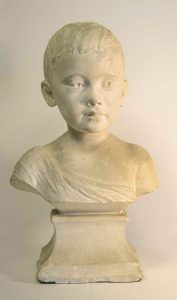 This is not how most of us think of Pomona’s third and perhaps best known president, James A. Blaisdell, but like the rest of us, he was once a child, and unlike most of us, he had his likeness recorded at the age of about six in the form of a plaster bust.
This is not how most of us think of Pomona’s third and perhaps best known president, James A. Blaisdell, but like the rest of us, he was once a child, and unlike most of us, he had his likeness recorded at the age of about six in the form of a plaster bust.
Blaisdell would grow up to become a minister, theologian and president of Pomona College from 1910 to 1927. Today he is perhaps best remembered as the principal founder of The Claremont Colleges consortium and the author of the quotes on Pomona’s gates.
The bust, done in the classical style that was popular at the time (including clothing the boy as a child would have been clothed in Greek or Roman times), may have been intended to be cast in bronze, but no one knows whether this was ever done. Dating from around 1873, Blaisdell’s childhood likeness remained in the Blaisdell family until it was donated to the College this year by his great-granddaughter Susan Blaisdell Cornett.
ITEM: Sculpture
DATE: Early 1870s
DESCRIPTION: Plaster bust, 18” x 10.5” x 8”
ORIGIN: Gift from Susan Blaisdell Cornett
If you have an item from Pomona’s history that you would like to see preserved in the Pomona College Archives, please call 909-621-8138.
Path to the Paralympics
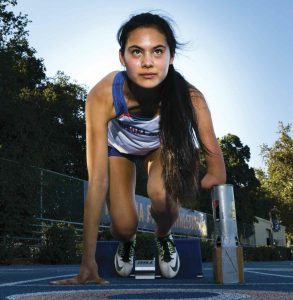 When Amy Watt ’20 got the call that she would be traveling to Rio de Janeiro in early September, her joy in making the U.S. Paralympic track and field team was tempered by worry about missing the first two weeks or so of her first semester at Pomona. She remembers calling Pomona-Pitzer Women’s Cross-Country and Track & Field Coach Kirk Reynolds with trepidation.
When Amy Watt ’20 got the call that she would be traveling to Rio de Janeiro in early September, her joy in making the U.S. Paralympic track and field team was tempered by worry about missing the first two weeks or so of her first semester at Pomona. She remembers calling Pomona-Pitzer Women’s Cross-Country and Track & Field Coach Kirk Reynolds with trepidation.
“I didn’t know who I should contact or what to do about missing some school,” recalls Watt. “He just asked when I’d be gone, information about the events, and the dates for everything. He talked to several people and the dean; he took care of a lot of it for me and made it easier for me.”
Born without part of her left arm, Watt has been an athlete since discovering soccer in kindergarten. She continued playing the sport until she fell in love with track and field in junior high school. “I was encouraged by my mom and friends,” says Watt. “It was also a fun activity to do.”
Her path from there to the Paralympics involved a couple of chance encounters and an aha moment concerning the rules.
One day during track practice at Gunn High School in Palo Alto, when Watt was in the 10th grade, a Gunn alumnus who is an amputee recommended that she check out the 2014 U.S. Paralympics Track and Field National Championships, being held in nearby San Mateo.
There she happened onto an amputee friend who was competing in a 4×100-meter relay. By chance, the group needed one more person. Watt agreed to fill in and was immediately hooked.
“Never thought I could do Paralympic track and field until I saw some other arm amputees and realized I could also do it,” says Watt, who had always assumed that those competitions were meant for leg amputees. What she discovered was that the International Paralympic Committee (IPC) has a classification system that determines athletes’ eligibility and divides them into sport classes with athletes with similar impairments. The category in which she was eligible was one that seems perfect for a Pomona-bound athlete—IBC classification T47.
Soon she was competing at the international level, traveling to the Netherlands for the International Wheelchair and Amputee Sports Federation World Junior Games and then to Toronto for the Parapan American Games, where she took fourth place in the 100- and 200-meter events. Last year, as a high school senior, Watt traveled to Doha, Qatar, where she participated in the IPC World Championships and came in fifth in the 400-meter dash and seventh in the long jump.
Between homework and world competitions, Watt had a tough decision to think about: college. Having decided she wanted to attend a Division III school, she got in touch with track and field coaches from her top choices.
When she visited Pomona, she was struck by the people she met and the tight community. “I liked that family feel before you get to campus. I liked having small classes; that’s something I really wanted in any school. I liked the general feeling on campus and could envision myself here being really happy. I met a lot of intelligent but humble people here.”
In Rio, Watt competed in three events—the long jump, in which she finished sixth; the 100 meters, in which she made it to the semifinals; and the 400 meters, in which she also finished sixth.
“Even though I didn’t perform as well as I had hoped in my events, the overall experience I had was incredible,” she says. “Now that I’m back, I’m catching up on a few assignments and other classwork that I missed, and all my professors have been understanding and supportive. I was touched that many of my classmates have congratulated me on my performance and watched some of my races.”
Although she’s not sure what she plans to major in, she is sure she’s going to continue track and field at Pomona.
“She is a remarkable jumper and sprinter who has had a successful high school career, and I know she can continue to improve her performance in all her events,” says Reynolds.
And though the next Paralympics won’t happen until her senior year is over, she can’t help thinking about it sometimes.
“Sometimes I still have a hard time grasping that I went and competed in the Paralympics,” she says. “It was such an unforgettable experience to be running with the best athletes in the world. I would love to go to Tokyo in 2020, but I’ll need to keep working hard to get better and perform well at trials.”
Stray Thoughts: The End of an Era
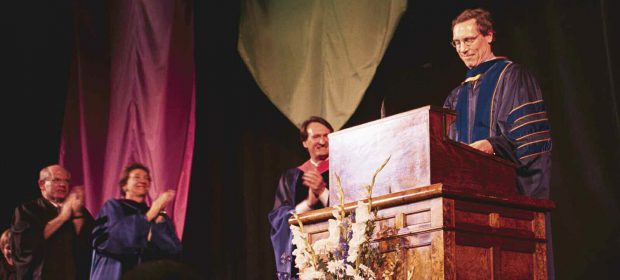 Nearly 14 years ago I wrote a column about the imminent departure of Pomona’s eighth president. It began with these words: “A college president is remembered for a word, a deed, a gesture—something personal to each one of us. A presidency, however, is remembered for more enduring things.”
Nearly 14 years ago I wrote a column about the imminent departure of Pomona’s eighth president. It began with these words: “A college president is remembered for a word, a deed, a gesture—something personal to each one of us. A presidency, however, is remembered for more enduring things.”
Forgive me for falling back on old words, but I can’t think of better ones as we now prepare to say goodbye to Pomona’s ninth president.
Personally, I’m sure the first thing I will remember about David Oxtoby is his phenomenal energy—the kind of energy required to take a red-eye to the East Coast, rush from meeting to meeting at a breakneck pace till long after dark, then fly home just in time to hurl himself into another trying 12-hour day—and do it day after day, month after month. Of course, I’ll also remember a particularly humanizing moment when that brutal schedule finally caught up with him, causing his eyelids to droop during a long, boring meeting.
And there are other indelible memories—like the carefully articulated Spanish in which he always addressed the gathering at the annual holiday luncheon for college staff in order to ensure that everyone was included in his message. Or the refreshing honesty and quiet civility with which he faced the inevitable storms that struck his presidency.
But that’s just my list. Others will have lists of their own—good memories and bad, but rarely indifferent. That’s a fact of life for college presidents—especially those who remain on the job for a decade or more. They tend to arouse strong feelings, one way or the other.
Which brings us to the question of how history will remember the Oxtoby presidency—and the corollary question of how much of the credit should go to the person at the top.
David Oxtoby would be the first to point out that college presidents accomplish very little by themselves. In looking back at these 13-plus years, he prefers to talk about the College family as a whole and what we have accomplished together. However, the truth is that institutional progress is a messy business, full of fits and starts that can easily devolve into a morass of conflict and well-intentioned ineffectiveness. It takes a rare combination of temperament and skills in order to manage it successfully.
Indeed, very little of consequence happens at a place like Pomona without bearing the president’s fingerprints in some way or other—through an overall vision, a specific goal, a set of priorities, a mediation between warring parties, or simply a well-timed word of encouragement. In this particular case, I think some of the biggest accomplishments of the Oxtoby years—like the dramatic upturn in the diversity of the student body or the highly successful Daring Minds Campaign—have his fingerprints all over them.
There are still eight busy months to go in the Oxtoby era, but even as the work goes on, the institution is beginning to look forward—with sadness, nostalgia, excitement and trepidation—to the dawn of a new era. But before we turn that page, we invite you to join us for a look back at the Oxtoby years, with a focus on both a transformational presidency and the remarkable person behind it.
Aboard the Vallejo
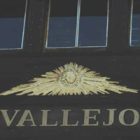
eric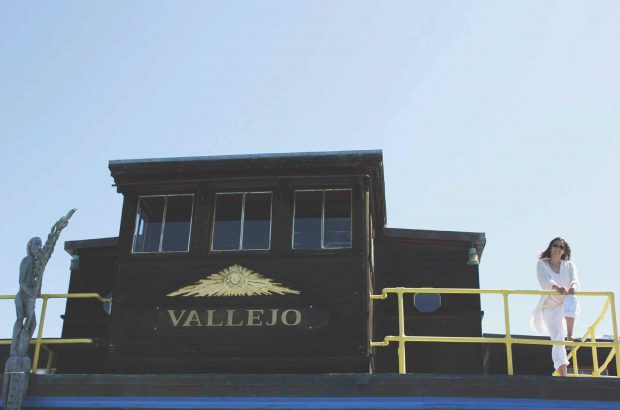
On the first morning of my writing residency, I looked out the window and was filled with dread. ‘It’s back,’ I thought. For months I’d been battling episodes of vertigo, which seemed to strike after changes in elevation. And since I’d just flown from the mountains of Colorado and landed at sea level, I was sure it was back, and just in time to thwart this dream opportunity. Fortunately, what I thought was an imbalance in my inner ear was actually the gentle swaying of the outside world. After all, I was on a boat, a houseboat in fact—the SS Vallejo—home to the newly created Varda Artist in Residence (VAR) Program.
The Vallejo had a rich history before landing in the hands of the current owners and program directors. Originally a passenger ferry in Oregon, after being decommissioned, the Vallejo was due to be sold for scrap metal. Fortunately, in the magical year of 1947, Jean Varda bought the boat and turned it into an artists’ haven in Sausalito, CA. Varda invited others, such as Alan Watts, Gary Snyder, and Allen Ginsberg to join him. Soon the boat was a flourishing artists’ community, complete with a reputation for wild parties that experimented with alternative ways of thinking. The Vallejo also became home to many of the Beat poet gatherings, as well as the conversations Alan Watt recorded that came to be known as the “Houseboat Sessions.” After Varda’s death in 1971, the boat changed hands several times. In 2015 the Vallejo officially became the home of the VAR program.
Après Le Deluge
After Rimbaud
After the idea of the deluge
ended, a little hare appeared
in the moving flowers, spoke
of rainbows lighting the spaces
of a spider’s web: the colors,
it said, can be seen only
after the years of darkness.
But the stones, the old
unbelievers, remained unmoving
in the streets, and watched
as the same stalls were erected,
the same ships were hauled to sea.
Only the children, looking out
from their big glass houses, saw
the New World like a painting,
like something from a dream.
Among the other artists with me were a rock musician from New York, a sound artist from Portland, Ore., and a visual artist from New Zealand. Not only was I the only writer, I was also the program’s first poet. Before my arrival, I’d just completed my first full-length poetry collection, My Dark Horses, and I was waiting to hear news from publishers. Given that I’d been writing about the rather heavy topic of my childhood, I felt both a sense of accomplishment and relief after finishing the book, and I was looking forward to using the residency to tackle something new. Originally I’d planned to translate the French poet Arthur Rimbaud’s Illuminations. However, only a few days into the project, and with the boat’s rich inspiration, I found myself creating a sheaf of my own new poems that built off Rimbaud’s poetry.
I was delighted by the simple yet elegant space I’d been given for my work. My room was a freshly painted white, and three of its walls had expansive views of Sausalito Bay. Blooming plants were in every corner, and the large windows allowed the fresh air and the music of the ocean and birds to enter. I faced my desk toward the long view of the water and unpacked my favorite collected poems: by Philip Larkin, Robert Frost, Sylvia Plath, and Donald Justice. I placed them next to my computer and was ready to work.
However, no progress was to be made without a strong cup of coffee. I unpacked my stovetop espresso maker and beans and figured I’d be set. After looking around the kitchen, I was surprised to find I’d be grinding my beans by hand and working up a sweat from turning the crank hundreds of times. I eventually grew accustomed to this ritual and even came to enjoy it. But as it turned out, the real coffee challenge was yet to come. One of the unique things about houseboat living is that one must climb a ladder to reach one’s room. Other than the possibility of a drunken stumble or unexpected bout of vertigo, it hadn’t occurred to me that the ladder would be an obstacle—I was forced to devise a system. First, I’d take a few sips to lower the coffee level in my mug and to give myself a small shot of caffeine, should I need to make a quick save during transport. Then, I’d hold the side of the ladder with my left hand moving the coffee up one rung at a time with my right. Meanwhile, my feet followed suit, one rung at a time, until my coffee and I were both safely delivered up the ladder to my desk and my computer.
I’m sure this looked ridiculous, particularly to the others who simply drank their coffee in the kitchen and avoided the drama altogether. But aside from enjoying my coffee in solitude, I’d developed this quirk of needing a mug of coffee beside me while I worked; thus the struggle was worth the effort.
Vagabonds
After Rimbaud
Oh, pitiful brother,
I cannot be your sister
you cannot be my brother,
since you are still a mistress
to our late mother—
Many years have passed,
and these days I wonder,
what’s become of you
and what foreign land
do you these days inhabit?
Russia, Japan, China,
in that mind of yours
you were never right.
But what if now we met?
Could I restore you
to your original state;
or would you drag me,
just as She did,
into your dark room
of old howling sorrows?
Bringing an empty coffee mug, or anything for that matter, down the ladder was much easier than taking it up. When I first arrived, I’d made a dozen or so trips up and down carrying my clothes and books in small, backpack-sized deliveries. But at one point, the rock musician suggested to me: Why not just throw your clothes down? An excellent idea I wished I’d thought of myself! This began the jettisoning of shorts, dresses, and pants to the main level of the boat in a Great Gatsby-esque moment of liberation. I’m sure, at the very least, the Beat poets would have approved.
The program allowed as much or as little contact with the outside world as we liked. Some of the artists spent their days exploring the offerings of San Francisco, while others stayed on the boat. I was of the latter, less hip group. Among other reasons for this was the chance to observe a tragic pair of resident seagulls. This couple squawked outside my room early each morning; then walked on the roof with such deliberation that I wondered if two very serious lawyers were debating above me. One day I noticed that the gulls had built their nest precariously atop one of the pier’s wooden piles. Upon some investigation, I learned that each year their nest fell terribly into the ocean—the eggs lost to the deep blue. The parents cried out in painful squawks of loss, buried their beaks dejectedly in each other’s feathers, and seemed to mope around the boat until their grief passed. And yet each spring they’d rebuild their nest in the same place, and the same disaster ensued. I wondered what kinds of bird-brained behavior my fellow artists were witnessing on the streets of San Francisco.
From time to time the Vallejo hosted its share of social gatherings. These were nothing like the famed wild parties of the Beat Generation, but rather intimate events that allowed each artist to display his or her work. On our last evening, we ate salmon from the local fishmonger, broiled with fresh cherries. We made a colorful salad, cut thick slices of bread and drank plenty of California wine. Each of us gave a short presentation describing how the boat had inspired or changed our work during our stay. Later that night, we piled into a rowboat and quietly reflected on our time spent on the Vallejo. For my part, I chose to row—pushing the old wooden oars quietly through the dark waters.
NOTE: The Vallejo’s owners have requested that we note that the boat is not open to the public.
New Pomona Faculty
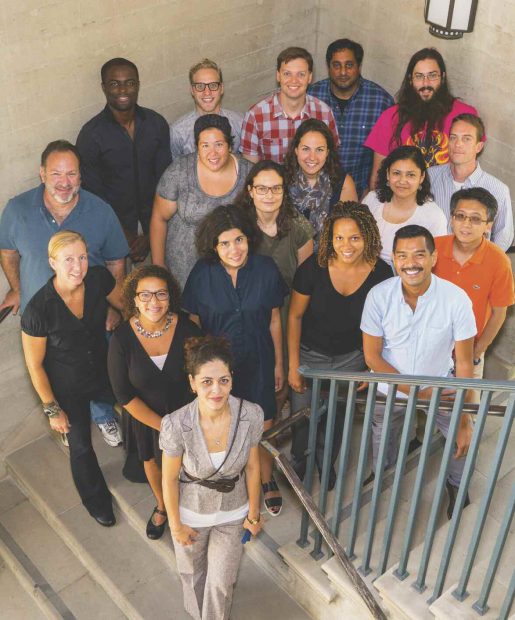
Every fall, Pomona College welcomes a special group of people to campus: new professors, visiting professors, lecturers and fellows. This year the College has a group of 36, including, from left to right: Back row: O. Maduka Ogba, Robbins postdoctoral fellow in chemistry; Mark Caspary, post-M.F.A. fellow in theatre and dance; Scott Medling, visiting assistant professor of physics and astronomy; Vivek Swaroop Sharma, visiting assistant professor of politics; Peter Andrew Mawhorter, visiting instructor in computer science; second row from back: Robin Melnick, instructor in linguistics and cognitive science; Kimberly Ayers, visiting assistant professor of mathematics; Jill Pace, assistant professor of physical education and women’s basketball coach; Tyler LaPlante, visiting assistant professor of economics; third row from back: Kara Wittman, director of college writing and assistant professor of English; Patricia Blessing, visiting assistant professor of art history; Guadalupe Bacio, assistant professor of psychology and Chicana/o-Latina/o studies; Lei Shao, visiting assistant professor of economics; fourth row from back: Nicole Holliday, Mellon Chau postdoctoral fellow in linguistics and cognitive science; Joanne Nucho, Mellon Chau postdoctoral fellow in anthropology; Carolyn Ratteray , assistant professor of theatre and dance (now tenure-track); Giovanni Ortega, assistant professor of theatre and dance (now tenure-track); and front: Katya Mkrtchyan, visiting instructor in computer science. Not pictured: Nani Agbeli, lecturer in music and director of the West African Music Ensemble; Richard Asante, visiting African scholar in international relations; Martha Bárcenas-Mooradian, lecturer in Romance languages and literatures; Zaylin Cano, lecturer in dance; Brett Hershey, lecturer in theatre and design; Rushaan Kumar, visiting assistant professor of gender and women’s studies; Whitney Mannies, lecturer in politics; Audrey Mayer ’94, lecturer in environmental analysis; Sam Miner ’06, lecturer in mathematics; Claire Nettleton, lecturer in Romance languages and literatures; Alexandria Pivovaroff, lecturer in environmental analysis; Elm Pizarro, lecturer in dance; Meagan Prahl, lecturer in theatre and dance; Andrew Sappey, visiting assistant professor of chemistry; Meghan Sisson, visiting assistant professor of physical education and men’s and women’s swim coach; Corey Sorenson, visiting assistant professor of theatre; Ousmane Traoré, assistant professor of history and Africana studies; and Samira Yamin, lecturer in art.